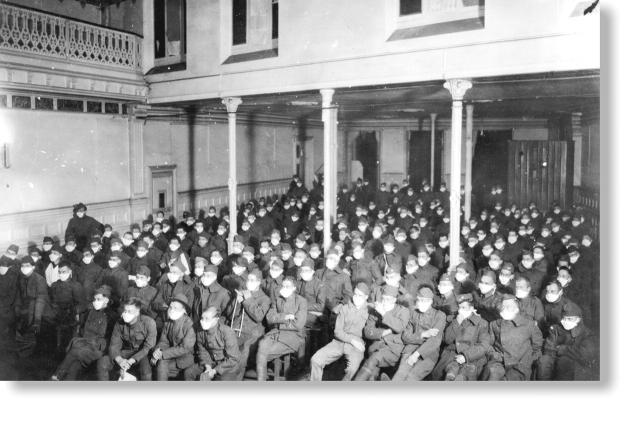THIS PHOTOGRAPH ▶, TAKEN IN 1918 at US Army Hospital Number 30 in Royat, France, shows servicemen watching a movie. While a civilian debate raged over the compulsory wearing of masks as a means of slowing the transmission of influenza, military authorities through the chain of command were more readily able to impose this requirement on the troops.1 In the United States, a committee of the American Public Health Association stated that any type of gathering of people involving mixing of bodies and sharing of breath in crowded rooms was dangerous. It advised that saloons, dance halls, and cinemas should be closed and public funerals prohibited as unnecessary assemblies.
Figure .
Source. Prints and Photographs Collection, History of Medicine Division, National Library of Medicine.
The influenza pandemic spread worldwide through 1918–1919, during the later phases of the war. Military populations were particularly at risk, with many men living in close quarters. Even more significantly, the movement of troops contributed to spread the disease from military to civilian populations, from region to region, and from continent to continent. The net result was a devastating global pandemic that probably killed more people than the plague of the 14th century. In 6 months, influenza killed some 30 million people, more than 3 times the number of military casualties suffered by all of the belligerents during more than 4 years of fighting in what was then called the Great War.2
Note. Most of the Prints and Photographs Collection of the History of Medicine Division of the National Library of Medicine may be viewed through the on-line database “Images from the History of Medicine” at http://wwwihm.nlm.nih.gov. The Web site also provides information on ordering reproductions of images. If you have a print, photograph, or other visual item that might be appropriate for this collection, please contact the History of Medicine Division.
References
- 1.Crosby AW. America's Forgotten Pandemic: The Influenza of 1918. Cambridge, UK: Cambridge University Press; 1989.
- 2.Patterson KD, Pyle GF. The geography and mortality of the 1918 influenza pandemic. Bull Hist Med. 1991;65:4–21. [PubMed] [Google Scholar]



